You’ve probably heard the phrase, “the pen is mightier than the sword.” You might also want to believe that the toothbrush is mightier than the drill. That’s because if you properly wield your toothbrush, you can use it as a powerful weapon against tooth decay and gum disease. But like any tool, if you want it to work well, you need to take care of it.
That’s why you need to replace your toothbrush frequently to maintain proper oral hygiene.
It’s not a good sign if you don’t remember the last time you replaced your toothbrush. Don’t worry, we’re not here to call you out on that; we’re here to help you. In fact, you’ll probably ditch your toothbrush immediately after reading this article!
Change your toothbrush every 3 months
We recommend replacing your toothbrush every three to four months as toothbrushes can become worn out over time and when the bristles bend and fray, they become less effective at cleaning your teeth.
If you find that you often forget to replace your toothbrush on time, try putting a reminder in your personal calendar every quarter of the year to buy a new one.
Remember to always buy soft-bristled toothbrushes as those with hard or medium bristles can damage your enamel, making your teeth more vulnerable to tooth decay.
Know what the signs are to change
You may not be aware of this but toothbrushes can actually show you when it is time to change them. The most obvious sign you will see is that the bristles have started fraying and splaying outwards instead of standing up straight.
Sometimes the frayed bristles could be caused by you brushing your teeth too hard. If your brush’s bristles fray too soon after you’ve just bought them, it may be a sign that you’re using a little too much force when cleaning your teeth.
Avoid doing so as it can damage your teeth or cause sensitivity. The key is how thorough you are when brushing your teeth, not how hard you brush.

Know when to change your toothbrush
Switching to a new toothbrush every three to four months is a general recommendation, as individual factors may require you to do so more often.
For example, if you have braces, the bristles of your toothbrush may become frayed more quickly and therefore need a replacement more often. In fact, children’s toothbrushes will need to be replaced even more often than toothbrushes used by adults.
In some circumstances, you may even need to replace your toothbrush even if the bristles are not visibly frayed. If you have come down with a cold or flu, or have had a mouth or throat infection, sore throat, or a mouth sore, you should replace your toothbrush even if it’s new. This can help to prevent re-exposing yourself or others in your home to germs that could cause an illness.
If changing toothbrushes too often is not something you see yourself doing, there are some things you can do to help your toothbrush last a bit longer:
- Rinse your toothbrush vigorously under cold running water after each use to remove any excess toothpaste and debris
- Store toothbrushes upright, in the open, and not touching one another so they have a chance to dry between uses
- Use a plastic case to protect the bristles when you travel
- Never share your toothbrush with anyone else
Alternatively, you can soak your toothbrush in alcohol to kill the germs. Mouthwash is also an antiseptic so it works as a “toothbrush soak”. So does a solution of half water and half hydrogen peroxide. If chemicals aren’t your thing, it is fine to dip it in boiling water for about five to ten seconds.
